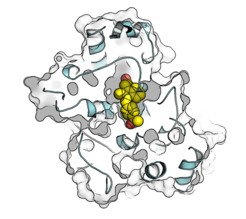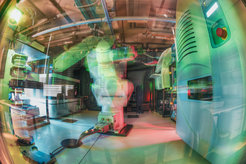Promising substance against rare cancer licensed out
Success for drug researchers at the University Alliance Ruhr
Around 1,200 Germans are diagnosed with gastrointestinal stromal tumours (GIST) every year - a rare type of cancer in which the tumours develop in the walls of the digestive organs and which quickly develop resistance to common precision drugs. Scientists at TU Dortmund University, the West German Tumour Centre Essen and the Max Planck Institute of Molecular Physiology in Dortmund have identified a promising active substance against GIST, applied for a patent and licensed it to a US pharmaceutical company, which now wants to develop it further until it is ready for the market - an important step on the path from basic research to clinical application

The teams led by Prof. Dr. Daniel Rauh from the Faculty of Chemistry and Chemical Biology at TU Dortmund University, Prof Dr Sebastian Bauer from the Faculty of Medicine at the University of Duisburg-Essen (UDE) and Dr Sonja Sievers, Head of the Compound Management and Screening Center at the Max Planck Institute of Molecular Physiology identified a chemical substance that proved to be highly effective against drug-resistant GIST cells in preclinical laboratory tests. The universities and the MPI filed a patent application for the active substance and with the help of PROvendis, the commercialisation company of 29 NRW universities, it was immediately licensed out to a US pharmaceutical company, which will drive forward clinical development.
‘This success shows the enormous potential of drug research within the University Alliance Ruhr,’ says Prof. Dr. Daniel Rauh. ‘The development of a new drug usually takes ten years or longer. The special thing about this success is that the compound was already tested years ago with a different focus. At that time, however, it was not convincing. Now we were lucky enough to have rediscovered this substance.’
‘COMAS is the central substance library of the Max Planck Society and contains over 300,000 small molecules. In the current project, we have screened over 25,000 substances from this molecular treasure trove and were able to find the promising GIST drug. Our setup, which is unique in Germany, makes it possible to translate research results into medical applications,’ says Dr. Sonja Sievers, Head of COMAS.
The cell cultures for preclinical testing of the potential active substances were established at the West German Tumour Centre: ‘Modern molecular biology methods such as gene scissors enable us to reproduce molecular variants of the tumours of our GIST patients in the laboratory in a very short time. We have thus established a dynamically growing model library that is unique in this form worldwide,’ says Prof. Dr. Sebastian Bauer. ‘The identification of our substance is therefore the result of integrated innovation cycles within the UA Ruhr that have grown over the years.’
As GIST is a very dynamic disease, resistance to the rediscovered substance is also likely to develop. The interdisciplinary team from the fields of molecular genetics, cell biology, high-throughput screening, structural biology and organic synthesis is therefore already working on successor substances.
The joint research was supported by the German Research Foundation (DFG), the Drug Discovery Hub Dortmund (DDHD), the CANTAR research network funded by the state of North Rhine-Westphalia, the IGNITE project funded by the Mercator Research Centre Ruhr and funds from the Sarcoma Tour and the David Foundation.


